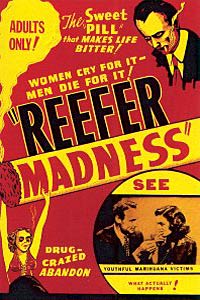Come Aboard, We’re Expecting You
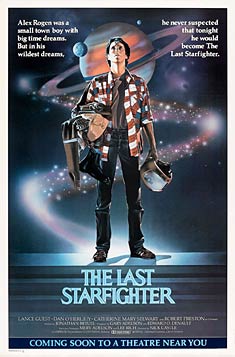 As military recruitment propaganda films go, I find The Last Starfighter to be something of an odd duck.
As military recruitment propaganda films go, I find The Last Starfighter to be something of an odd duck.
The Last Starfighter is ostensibly a mid-1980’s escapist entertainment about a trailer park kid who’s conscripted into some kind of galactic corps, thanks to his prowess at video games. But underneath, the film is something more nefarious – namely, yet another misguided government attempt to ramp up recruitment in lieu of mandating a draft, by making military service seem fun and adventurous.
Directed by Nick Castle, who co-wrote Escape From New York with John Carpenter, The Last Starfighter burst onto the scene in 1984 and if memory serves was largely embraced and cherished by the filmgoing populace.
Having seen the film last night, I’m left with one burning question. Why?
I went in with high hopes. Castle, after all, was the man responsible for much of the New York humor of Escape From New York, including the character of Cabbie. For my money, anyone who can shoehorn Ernest Borgnine into a John Carpenter film deserves an Oscar nod.
Our hero, Lance Guest, the trailer park kid with the hot hand, spends much of the film in a state of reluctance. I don’t really blame him. I spent much of this film in a state of reluctance, too.
Lance doesn’t embrace being the last starfighter because it’s dangerous, and he only agrees to take the helm after much cajoling from the supporting cast. Robert Preston never worked so hard. (It was a long time after The Music Man, but Bob still had the sparkle.) 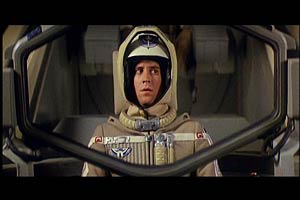
(SIDE NOTE: I spent a good deal of time worrying that I wouldn’t make it all the way through The Last Starfighter, which doesn’t bode well for my scheduled viewing of Battlefield Earth. I need your moral support. Please. The things I do for you people.)
Lance’s reluctance can be ultimately traced back to what I call “The Stubing Effect.” ™
The Stubing Effect refers to the fact that the Rylans (the good aliens Lance is conscripted to fight for) all look like Captain Stubing from The Love Boat.
Even the females.
When even the women in your film look like Captain Stubing from The Love Boat, you know you’re in trouble. Big trouble.
It’s the over indulgent use of Gavin MacLeod clones that I think is the downfall of this film. That, and the fact that the film is heavily laden with CGI. Now consider we’re talking 1984 CGI here. My Atari 2600 was pumping out better pixels than The Last Starfighter.
I could almost forgive the cheesy CGI. But the overuse of Stubing is too much.
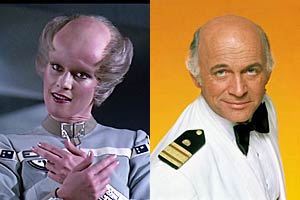 Now, I love Gavin MacLeod as much as the next person. I’m a big fan of The Gav. Big fan. But somehow His Stubingness just doesn’t translate well into science fiction.
Now, I love Gavin MacLeod as much as the next person. I’m a big fan of The Gav. Big fan. But somehow His Stubingness just doesn’t translate well into science fiction.
So I ask the United States Air Force (who undoubtedly was behind the making of this film), “As a recruitment film, do you really think female Stubings are the way to psychologically press gang young men into military service?”
Female aliens with male pattern baldness just don’t really impress me as a way to entice America’s youth to be all they can be.
Admittedly, I don’t remember much more from the film than that, reeling as I was from Stubingness. There was something called a Zando-Zan that looked like a crawfish taking potshots at Lance and his robot twin in a trailer park. And they finished the film with the dreaded Death Blossom starship attack. Beyond that, it’s a blur.
For my money, the better military recruitment film from 1984 was Red Dawn, featuring well-choreographed Patrick Swayze musical numbers. “Nobody puts Baby in a corner!” Now isn’t that exactly the go-get ’em attitude you want from your armed forces?
DON’T FORGET – BATTLEFIELD EARTH CHARITY CHALLENGE!
Worlds Without End created a tribute fund through St. Jude Children’s Research Hospital –
Help us reach our charity goal. Make a donation, be my charity sponsor, and I promise I will sit through an entire viewing of Battlefield Earth, no matter how painful it gets.Laser Madness
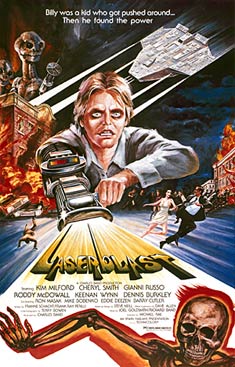 I’m not much of a film critic.
I’m not much of a film critic.
I can admit it. The reason I can admit it is that I know I just don’t have the heart to slam a movie just because it’s a bad movie.
For me, “bad” is not enough of a qualifier to unleash on a film. Picking on a bad movie is like kicking a guy when he’s down. They’ve suffered enough. I’d rather save the sarcasm for the movies (and filmmakers) who are wildly successful. They can take it.
Having tried my hand at screenwriting (and having no luck at it), I learned to respect the process. I’ve been there. The shameless hawking of a story idea to anyone who’d listen. The rewrites of rewrites. Query letters. Trying to get an agent. Plowing through screenwriting books. All that.
If nothing else, the experience taught me that if a person actually does get a story turned into a movie, that’s really something. It’s a lot of work, and you really have to care strongly about what you’re doing if you even want a shot at seeing it through.
To sell a screenplay is a big deal. To see it then turned into a movie is a huge deal.
I firmly believe no one ever sets out to write a bad movie.
Because of this, I give “bad” movies slack. I try to look beyond their faults and weigh what their creators were trying to do or say.
All this is lead up for today’s review of what has been universally reviled as one of the worst movies of all time. The 1978 science fiction opus known as Laserblast.
For those of you unfamiliar with the film, it relates the tale of Billy, whom we are to understand is a much put-upon teenager, and the aftermath of his discovery of an extraterrestrial weapon of mass destruction. We follow Billy as he goes on a rampage against those who torment him, before finally descending into madness, mutation and eventual death at the hands of the aliens who return to Earth to reclaim the weapon.
Having watched it last night, my head is still awash in its non sequitur narrative and undisciplined editing. Admittedly, the movie almost begs to be mocked. The dialogue. The acting. The effects, which fail one of the fundamental rules of science fiction cinema, a little something I call “The Krofft Rule.”
Essentially the rule states that your special effects m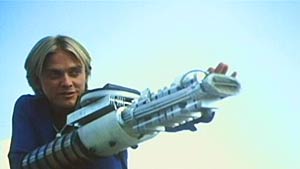 ust be measurably better than something that Sid and Marty Krofft manufactured during their TV entertainment heyday. If you’re rolling out a full-fledged film and you can’t outshine the Krofts’ “Grumpy the Tyrannosaurus,” you’re in big trouble.
ust be measurably better than something that Sid and Marty Krofft manufactured during their TV entertainment heyday. If you’re rolling out a full-fledged film and you can’t outshine the Krofts’ “Grumpy the Tyrannosaurus,” you’re in big trouble.
I knew Grumpy. Grumpy was a friend of mine. And Laserblast, you’re no Grumpy.
Laserblast featured (“starred” is too strong a word choice) Kim Milford as Billy. For you Jeff Beck freaks out there, Kim sang lead vocals for the Jeff Beck Group for roughly two weeks during the summer of 1972. (You would have to be a pathological Jeff Beck fan to know that, which I’m not.)
Milford would find more rewarding work as the villain opposite Mark Hamill (aka Luke Skywalker) in one of cinema’s greatest triumphs of the late 1970s.
I’m talking, of course, about Corvette Summer.
Anyway, in Laserblast we follow Milford as he becomes a deranged mutant killer blasting cars, people and domiciles with the laser weapon that happenstance has placed in his care.
Rather than get hung up on its shortcomings, I spent some time reflecting on Laserblast and the message that its filmmakers might have been trying to tell us.
I think I’ve found something.
Laserblast is noteworthy in its nihilism in that the hero is also the villain. There is no real foil to Billy, until the very end when the aliens blast the rampaging youth in an act of supernatural justice.
As an audience, we are confused as to who we’re supposed to root for. Rather, we watch helplessly as our hero self-destructs. The fact that we don’t really care because the film is so bad is beside the point. This led me to surmise that Laserblast is actually a sort of cautionary tale. If it’s a cautionary tale, what are we being cautioned against?
Laserblast is the Reefer Madness of the space era.
Eureka! Of course. The parallels are obvious.
In Reefer Madness, troubled youth of the 1930s taste forbidden fruits, go insane and dead end in a fatal crime spree.
In Laserblast, troubled youth of the 1970s taste forbidden fruits, go insane and dead end in a fatal crime spree.
Looking at Laserblast from this angle, you can deduce deeper meanings behind the deaths of Billy’s victims. Also telling is who among the film’s cast survives Billy’s rampage.
In essence, almost no figure with real authority dies in the film. Not Billy’s absentee mother, who makes a brief cameo before jetting off to Acapulco. Not the mysterious government agent. Not Billy’s girlfriend’s grandfather, the Colonel. Not the hapless town sheriff.
The deaths are relegated to the two bumpkin deputies, two bullies (the most unlikely bullies you will ever meet – remember Mandark from Dexter’s Laboratory?), and Roddy McDowell.
(McDowell, who plays a doctor in the film and hence an authority figure, wasn’t supposed to die in the original script, but he begged to be off’d after he realized what the film was going to do to his career.)
So, no one of significant authority is killed. And in fact, it’s telling that the two bumpkin deputies are seen smoking a doobie early in the film, a precursor to later onscreen fatality if ever there was one.
Like Reefer Madness, Laserblast was intentionally mad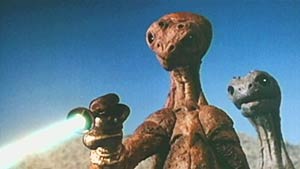 e to demonstrate the inherent dangers of a forbidden fruit and to scare kids away from it.
e to demonstrate the inherent dangers of a forbidden fruit and to scare kids away from it.
In Laserblast’s case, that forbidden fruit was alien technology.
What it all boils down to is this. A government plot to keep us from using alien weapons of mass destruction.
Think I’m kidding?
Listen, in the late 70s we were still getting our outer space on. Shuttles, Voyager satellites, stuff like that. Who knew what kind of stuff we’d shake lose from the stars. You poke a finger at the stars, they might poke back.
Remember the times in which Laserblast was made. The year before, Richard Dreyfuss was making mashed potato sculptures and getting unexplained suntans.
The government had to hedge their bets. They had to spread the word.
If you find something that looks outer-spacey, don’t touch it! You could end up like Billy!
That’s right. Laserblast was a government propaganda film. How else could it have been so bad?
Long, Long Way From Home
 Maybe it’s just me.
Maybe it’s just me.
Maybe I just have kooky associations that run through my head. I don’t know.
But, for some reason, whenever I listen to Foreigner, I think of Close Encounters of the Third Kind. Particularly Feels Like the First Time.
Okay, yes, I know, I just admitted to listening to Foreigner. Since I’ve already established that I like science fiction, it’s safe to assume I’m a bit socially awkward. The “Foreigner” confession just seals the deal. I still managed to move out, get married and have four kids. So there.
But truth be told, Feels Like the First Time harkens me back to 1977, when both Foreigner and Close Encounters arrived from some far distant place and emblazoned themselves on the world consciousness in an array of light and sound. (Actually, Foreigner formed in New York, but that’s a pretty alien place in its own right. And don’t aliens technically qualify as “foreigners”?)
Sitting here, listening to the amorous musical odyssey of Lou Gramm and his perm, I find myself waxing philosophical about Mr. Holland’s other Opus, Close Encounters. It had going for it the three things every American filmgoer was clamoring for in the Me Decade: Aliens! Outer space! François Truffaut!
So, the question dogging me is this: What happened when Roy Neary came home?
You know, I had never really considered the ramifications of his departure until I watched Spielberg discussing the film on a documentary. In that, he famously said that if he made Close Encounters now, as a father, he wouldn’t have had Roy leave Earth and his family behind.
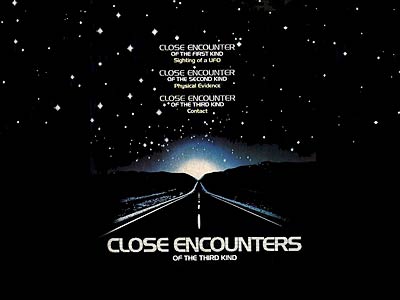 It’s an emotionally rich situation, and one that I hadn’t really considered before. I suspect that, like most audience members of the time, I didn’t factor that. I mean, c’mon, I was eight years old. I wanted Roy to take the ride.
It’s an emotionally rich situation, and one that I hadn’t really considered before. I suspect that, like most audience members of the time, I didn’t factor that. I mean, c’mon, I was eight years old. I wanted Roy to take the ride.
These days, with a family of my own, I’d be fascinated to see how the drama would play out if Roy returned.
Picture a kind of “Next Encounters of the Third Kind.” Here we are, 33 years later, and erstwhile Muncie electrician Roy Neary turns up to close the loop with the people he left all those years before.
His long-suffering wife Ronnie and their kids Brad, Sylvia and Toby, all now older than their father was when he left.
Can you imagine the emotional baggage being carried around by that group?
When the Neary clan last saw Dad, his passion for experimental gardening had gotten the better of him. Mom trundled the kids into the Vista Cruiser in a mad dash to get away from the old man for the safety of grandma’s. But at some point, they would have to return – and they would never know what became of their father.
Perhaps the government would feed them a line about how he perished in the toxic nerve gas spill in Wyoming. Perhaps not. Perhaps the family would simply think Dad flipped his cracker and disappeared forever. There’s a lot of unresolved pain there that we, as an audience, are oblivious to. But if we project forward along the narrative lines of those characters lives, we can certainly imagine the difficulties left behind in the wake of Roy’s decision to hitch a ride. I think it’s been said by others that Close Encounters of the Third Kind serves as a parable for divorce in the 1970s. That seems right to me.
So imagine Roy showing up now. Let’s say for argument’s sake he gets dropped off in a low-key affair. No government agents. No Devil’s Tower. No witnesses.
What kind of reception would he get when he found his way back to his family? Could he even find them? How could he explain himself to his wife and to his kids? How could he prove his story?
What if Ronnie was remarried?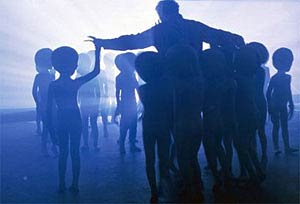 And what about Brad’s, Sylvia’s and Toby’s spouses and their kids? How would all those people deal with Roy’s re-entry?
And what about Brad’s, Sylvia’s and Toby’s spouses and their kids? How would all those people deal with Roy’s re-entry?
And what about Roy’s somewhat-surrogate family, Jillian and Barry Guiler? What is his emotional responsibility, if any, to them? You would assume that, having shared the monumental emotional experience that an alien close encounter would conceivably entail, they would have some kind of bond that would necessitate Roy bringing some closure to them as well.
Further complicating matters, how would Roy’s wife Ronnie feel about Jillian? Would she be jealous? We can presume that Roy’s kids wouldn’t have strong feelings about Barry, being they would likely be overwhelmed with issues about their long-lost absentee father, but what if Roy and the now-adult Barry shared the bond of their abductions? Would Roy’s kids understand why Dad seemed to favor this stranger?
And what about Roy himself? What kind of emotional turmoil would he be dealing with?
Conversely, what if Roy returned with the aliens in a grandiose, media-saturated manner? Everyone in the world hangs on his every word as Roy relates his experience on CNN. But what do his wife and kids think of the man who left them behind so he could boldly go where no Neary had gone before?
There would be a myriad of emotional dramas and issues to be dealt with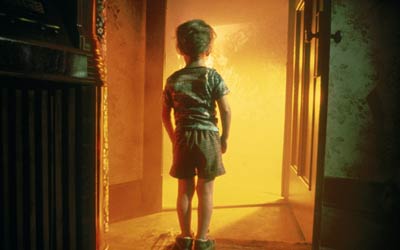 by the Nearys and the Guilers, regardless of the manner of Roy’s return.
by the Nearys and the Guilers, regardless of the manner of Roy’s return.
Admittedly, these are interior dramas and not the stuff of massive CGI budgets, but I think for me this is the kind of stuff that is important for science fiction, nonetheless. It’s what makes it real.
They say you can’t go home again. But I think it would be neat to try.
Wash. Rinse. Defeat.
Like most geeks, I am pretty amped up about the impending Tron sequel, Tron Legacy (yes, I know that I just used this space last week to rail against sequels and remakes; sue me – you think I get paid for this stuff?). Like most geeks, I have watched the trailer several times. And like most geeks, the trailer has left me with a burning question.
Namely, what’s with the albino guy?
If you haven’t seen the trailer, there is a fleeting glimpse of an albino doing an air guitar thing with a cane. A brief look at the blogosphere shows that this is a question that has lit a fire under Geek Nation.
Most bloggers I’ve seen are speculating that it’s either David Bowie or Jim Carrey (or both). However, the intrepid investigative journalists here at Worlds Without End have discovered that the albino is actually one of the Winter Brothers (we’re not sure which one, but my money’s on Edgar).
In honor of the serious hairdo sported by the presumed cyber-baddie, the WWE staff reached out to the American Society of Beauticians to help us create a list of the Top 10 Best Villainous Hairdos in Science Fiction. What follows is the result of months of furious polling by beauticians, barbers and hair aficionados from around the country.
Top 10 Best Villainous Hairdos in Science Fiction
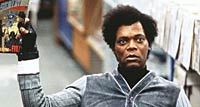 10. Elijah Price (played by Samuel L. Jackson) / Unbreakable (2000) – The man who originally spelled out for audiences that a big head is a hallmark for the bad guy. “Jules” popped the ‘fro ala Sly & The Family Stone style, knowing that it would eventually all get shaved off before he tackled the mother-f’ing snakes on the mother-f’ing plane.
10. Elijah Price (played by Samuel L. Jackson) / Unbreakable (2000) – The man who originally spelled out for audiences that a big head is a hallmark for the bad guy. “Jules” popped the ‘fro ala Sly & The Family Stone style, knowing that it would eventually all get shaved off before he tackled the mother-f’ing snakes on the mother-f’ing plane.
Did You Know?: His contract stipulates he must be given the coolest character name in any movie in which he is to appear.
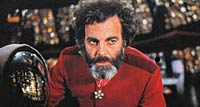 9. Dr. Hans Reinhardt (played by Maximilian Schell) / The Black Hole (1979) – Abandoned space craft. Black hole. Wild-eyed Bee Gee. Hello, can anyone say mad scientist? And what was up with Tony Perkins’ creepy mancrush? Gang, anyone named Dr. Hans on an abandoned space craft is NOT to be trusted.
9. Dr. Hans Reinhardt (played by Maximilian Schell) / The Black Hole (1979) – Abandoned space craft. Black hole. Wild-eyed Bee Gee. Hello, can anyone say mad scientist? And what was up with Tony Perkins’ creepy mancrush? Gang, anyone named Dr. Hans on an abandoned space craft is NOT to be trusted.
Did You Know?: He lost the part of Dr. Hans Zarkov in Flash Gordon to Topol, who was willing to do nudity.
 8. Benson (played by Harvey Keitel) / Saturn 3 (1980) – At first glance, the hair doesn’t seem like much, but flip up the bad midlife crisis ponytail, and you have a rocking Black and Decker brainjack that would prefigure the Wachowskis by two decades. Trend setter!
8. Benson (played by Harvey Keitel) / Saturn 3 (1980) – At first glance, the hair doesn’t seem like much, but flip up the bad midlife crisis ponytail, and you have a rocking Black and Decker brainjack that would prefigure the Wachowskis by two decades. Trend setter!
Did You Know?: Benson found new life in a spinoff series, starring Robert Guillaume, spending seven seasons in ABC’s prime time line-up.
 7. The Predator (played by Kevin Peter Hall) / Predator (1987) – Fan of corn rows ever since seeing Bo Derek in “10.” After his cameo role in Blake Edwards’ planned sequel “11” was scrapped, he went on a murderous rampage in South America, helping Jesse Ventura find time to bleed.
7. The Predator (played by Kevin Peter Hall) / Predator (1987) – Fan of corn rows ever since seeing Bo Derek in “10.” After his cameo role in Blake Edwards’ planned sequel “11” was scrapped, he went on a murderous rampage in South America, helping Jesse Ventura find time to bleed.
Did You Know?: He was a Colgate toothpaste model in the early 1970s.
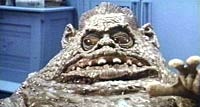 6. Chet Donnelly (played by Bill Paxton) / Weird Science (1985) – In what still stands as one of the wonders of pre-CGI Hollywood, wunderkind director John Hughes managed to realistically coif Rodney Dangerfield’s prostate. And Chet had the nerve to ask Vasquez if she’d ever been mistaken for a man?
6. Chet Donnelly (played by Bill Paxton) / Weird Science (1985) – In what still stands as one of the wonders of pre-CGI Hollywood, wunderkind director John Hughes managed to realistically coif Rodney Dangerfield’s prostate. And Chet had the nerve to ask Vasquez if she’d ever been mistaken for a man?
Did You Know?: He successfully ran Al Franken’s senatorial campaign in Minnesota.
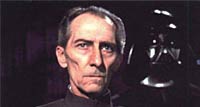 5. Grand Moff Tarkin (played by Peter Cushing) / Star Wars (1977) – Who else but a Hammer vet could take grandma’s hairdo and infuse it with such menace? Was it just me, or did Princess Leia actually flee into the arms of Darth Vader to get away from Granny Cushing? Really? Darth Vader? Like he’s going to protect you? Well, he was your father.
5. Grand Moff Tarkin (played by Peter Cushing) / Star Wars (1977) – Who else but a Hammer vet could take grandma’s hairdo and infuse it with such menace? Was it just me, or did Princess Leia actually flee into the arms of Darth Vader to get away from Granny Cushing? Really? Darth Vader? Like he’s going to protect you? Well, he was your father.
Did You Know?: He lent his hair to Jeff Conway for the 1978 film production of Grease.
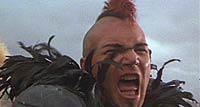 4. Wez (played by Vernon Wells) / The Road Warrior (1981) – Back when Mel Gibson traffic problems were a good thing, Wez epitomized the cliché that real men don’t ask for directions. This snarling ball of contempt for roadside assistance would later go quasi-gay as a henchman in Schwarzenegger’s Commando. Do you really want this guy going commando?
4. Wez (played by Vernon Wells) / The Road Warrior (1981) – Back when Mel Gibson traffic problems were a good thing, Wez epitomized the cliché that real men don’t ask for directions. This snarling ball of contempt for roadside assistance would later go quasi-gay as a henchman in Schwarzenegger’s Commando. Do you really want this guy going commando?
Did You Know?: He would later play tight end in the too-short lived XFL.
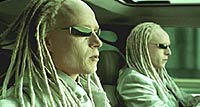 3. The Twins (played by Neil & Adrian Rayment) / The Matrix Reloaded (2003) – Eschewing their status as 70’s rock legends, Edgar and Johnny Winter tapped their inner Bo Dereks and dialed up some serious ghost ninja juju. Wardrobe by Mark Shale.
3. The Twins (played by Neil & Adrian Rayment) / The Matrix Reloaded (2003) – Eschewing their status as 70’s rock legends, Edgar and Johnny Winter tapped their inner Bo Dereks and dialed up some serious ghost ninja juju. Wardrobe by Mark Shale.
Did You Know?: They piloted The Suite Life of Marilyn Manson for the Disney Channel.
 2. Davy Jones (played by Bill Nighy) / Pirates of the Caribbean: Dead Man’s Chest (2006) – As Red Lobster’s spokesperson, he consummated the long-frustrated marriage of sex appeal and crab bisque. Plus, he gets bonus points due to the fact that his hairdo is prehensile.
2. Davy Jones (played by Bill Nighy) / Pirates of the Caribbean: Dead Man’s Chest (2006) – As Red Lobster’s spokesperson, he consummated the long-frustrated marriage of sex appeal and crab bisque. Plus, he gets bonus points due to the fact that his hairdo is prehensile.
Did You Know?: He co-starred in a revival of Goodbye, Mr. Chips.
And number one?
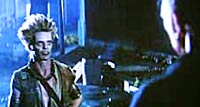 1. Romero (played by Frank Doubleday) / Escape From New York (1981) – Robert Pattinson, take note: this is unwashed hair that’s actually cool. With his prance, hyena laugh and octogenarian lingerie, Romero was “Cyndi Lauper” before being “Cyndi Lauper” was cool. “If you touch me, he dies. If you’re not in the air in 30 seconds, he dies.” He’s so unusual!
1. Romero (played by Frank Doubleday) / Escape From New York (1981) – Robert Pattinson, take note: this is unwashed hair that’s actually cool. With his prance, hyena laugh and octogenarian lingerie, Romero was “Cyndi Lauper” before being “Cyndi Lauper” was cool. “If you touch me, he dies. If you’re not in the air in 30 seconds, he dies.” He’s so unusual!
Did You Know?: He was the face of Jhirmack 1983.
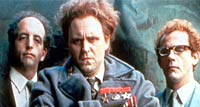 BONUS PICK! Dr. Emilio Lizardo / Lord John Whorfin (played by John Lithgow) / The Adventures of Buckaroo Banzai Across the 8th Dimension (1984) – Split personality meets split ends. Didn’t make the list proper because we couldn’t decide which one of him deserved the credit. The best villain in a Peter Weller film not to later star in That 70’s Show.
BONUS PICK! Dr. Emilio Lizardo / Lord John Whorfin (played by John Lithgow) / The Adventures of Buckaroo Banzai Across the 8th Dimension (1984) – Split personality meets split ends. Didn’t make the list proper because we couldn’t decide which one of him deserved the credit. The best villain in a Peter Weller film not to later star in That 70’s Show.
Did You Know?: He writes children’s books.
If you don’t agree with the results of this poll, please consult your beautician.



















 Full Details
Full Details
